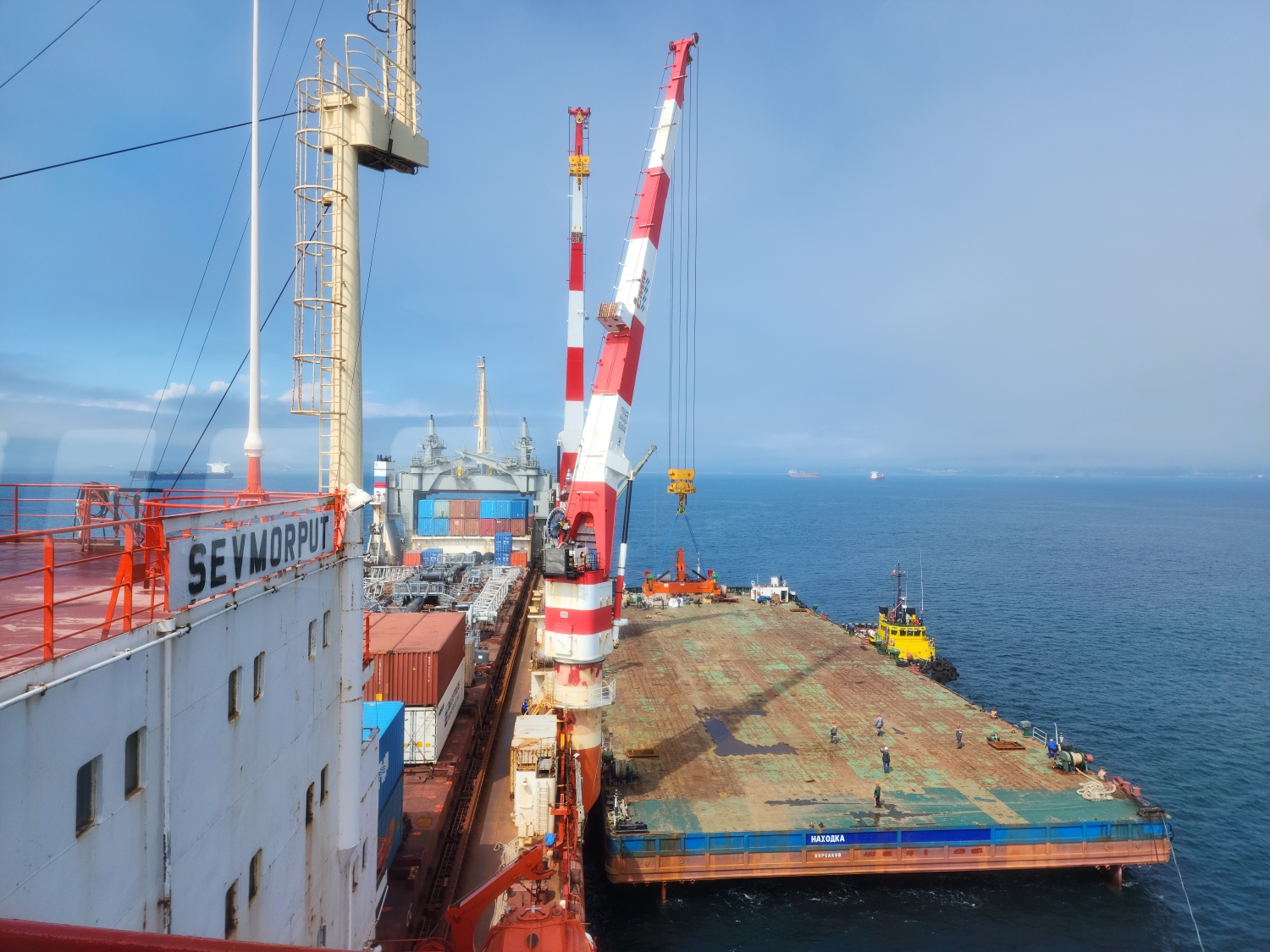The nuclear-powered ship will depart July 22-23 to head for Petropavlovsk-Kamchatsky

The Atomflot owned lighter aboard ship (LASH) Sevmorput with icebreaking capabilities and the KLT-40 nuclear-powered propulsion has arrived in the basin of Vostochny port (Wrangel Bay, Nakhodka Bay, Sea of Japan). This one-of-a-kind nuclear-powered ship completed her non-icebreaker-assisted voyage through the waters of the Northern Sea Route (NSR). The voyage is carried out as part of the Development of the Northern Sea Route federal project (of the Comprehensive Plan for the Modernization and Expansion of the Main Infrastructure), the Atomflot press office said.
“The voyage from St. Petersburg took 23 days. The route was plotted according to the recommendations of the Marine Operations HQ of GlavSevmorput. The crew ensured the delivery in normal mode of the main cargo to the Far East. We started unloading two heavy cranes at an offshore anchorage location. This operation has been worked out by the crew. After docking at the terminal, we will unload the containers,” Oleg Markov, the Sevmorput master said.
The departure from the Port of Vostochny is scheduled for July 22 – 23. The nuclear-powered icebreaking ship will bound for Petropavlovsk-Kamchatsky to deliver steel structures and lumber to Kamchatka and then to take aboard a shipment of reefer containers at the Port of Petropavlovsk-Kamchatsky.
During the passage from St. Petersburg to Vostochny port, the crew ensured scientific work of specialists from the Lomonosov Moscow State University’s Marine Research Center (LMSU MRC) who conducted observations of marine mammals and birds, as well as continuous measurements of salinity and water temperature along the entire route.
The Sevmorput departed June 24 from the Port of St. Petersburg and set out on her first subsidized short sea voyage along the route: St. Petersburg / Vostochny port, Nakhodka / Petropavlovsk-Kamchatsky / Murmansk.
The regular short sea shipping line was launched in 2022, with two voyages completed and three slated for this year. In addition, the number of calls will increase from 4 to 11. Arkhangelsk and Nakhodka were added to the list of ports of departure and destination, and the Port of Magadan was included in the itinerary.
On April 25, Atomflot agreed with the Ministry for the Development of the Far East and the Arctic on the schedule of subsidized short sea transportation of goods on the Sevmorput at preferential rates to the regions of the Far East and back to the European part of Russia for 2023. Then Atomflot reported that the container ship would set sail on the route: St. Petersburg - Vostochny port - Petropavlovsk-Kamchatsky - Murmansk on June 22. The start of the second subsidized voyage on the NSR is slated for October 10.
The Russian government began subsidizing Arctic short sea transport between the ports of St. Petersburg, Murmansk and the terminals of the Far East in 2022. Overall, RUB 7.84 billion are earmarked in the budget for these purposes until 2035, in accordance with the development plan of the Northern Sea Route (NSR). The Russian Ministry for the Development of the Russian Far East and the Rosatom State Corporation are responsible for the voyages arrangement.
Atomflot was announced the winner in a tendering process to select a contractor for execution of subsidized short sea cargo transportation in 2022. Two round trips took place from ports located in the European part of the Russian Federation to the Far East based ports. On August 11, the LASH Sevmorput completed the first voyage task with a 10% load of her capacity. During the second voyage in the direction of the Far Eastern ports the ship utilized to 90% of her carrying capacity, and in the opposite direction – 46%.
The nuclear-powered LASH Sevmorput (named after the Northern Sea Route) was built at Kerch based Zaliv Shipyard in 1988. The Sevmorput is intended for transportation of cargo to the remote northern areas of Russia. The ship can break through continuous field ice of up to 1 meter thick at a speed of about two knots and carry some 36,000 tonnes of cargo. With its hull design and strength the ship can operate in the Arctic basin independently or escorted by an icebreaker in more challenging ice conditions.



